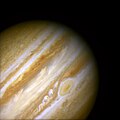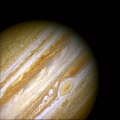File:An Ancient Storm in the Jovian Atmosphere - GPN-2000-000910.jpg

Original file (1,496 × 1,492 pixels, file size: 701 KB, MIME type: image/jpeg)
Captions
Captions
Summary edit
| DescriptionAn Ancient Storm in the Jovian Atmosphere - GPN-2000-000910.jpg |
English: When 17th-century astronomers first turned their telescopes to Jupiter, they noted a conspicuous reddish spot on the giant planet. This Great Red Spot is still present in Jupiter's atmosphere, more than 300 years later. It is now known that it is a vast storm, spinning like a cyclone.
Unlike a low-pressure hurricane in the Caribbean Sea, however, the Red Spot rotates in a counterclockwise direction in the southern hemisphere, showing that it is a high-pressure system. Winds inside this Jovian storm reach speeds of about 270 mph. The Red Spot is the largest known storm in the Solar System. With a diameter of 15,400 miles, it is almost twice the size of the entire Earth and one-sixth the diameter of Jupiter itself. The long lifetime of the Red Spot may be due to the fact that Jupiter is mainly a gaseous planet. It possibly has liquid layers, but lacks a solid surface, which would dissipate the storm's energy, much as happens when a hurricane makes landfall on the Earth. However, the Red Spot does change its shape, size, and color. Such changes are demonstrated in high-resolution Wide Field and Planetary Cameras 1 & 2 images of Jupiter obtained by NASA's Hubble Space Telescope, and presented here by the Hubble Heritage Project team. The Hubble images were originally collected by Amy Simon (Cornell U.), Reta Beebe (NMSU), Heidi Hammel (Space Science Institute, MIT), and their collaborators, and have been prepared for presentation by the Hubble Heritage Team. |
| Date | |
| Source | |
| Author | NASA, The Hubble Heritage Team, STScI, AURA, Amy Simon Cornell |
This image or video was catalogued by Space Telescope Science Institute of the United States National Aeronautics and Space Administration (NASA) under Photo ID: GPN-2000-000910 and Alternate ID: PR99-29A1. This tag does not indicate the copyright status of the attached work. A normal copyright tag is still required. See Commons:Licensing. Other languages:
العربية ∙ беларуская (тарашкевіца) ∙ български ∙ català ∙ čeština ∙ dansk ∙ Deutsch ∙ English ∙ español ∙ فارسی ∙ français ∙ galego ∙ magyar ∙ հայերեն ∙ Bahasa Indonesia ∙ italiano ∙ 日本語 ∙ македонски ∙ മലയാളം ∙ Nederlands ∙ polski ∙ português ∙ русский ∙ sicilianu ∙ slovenščina ∙ Türkçe ∙ українська ∙ 简体中文 ∙ 繁體中文 ∙ +/− |
Licensing edit
| Public domainPublic domainfalsefalse |
| This file is in the public domain in the United States because it was solely created by NASA. NASA copyright policy states that "NASA material is not protected by copyright unless noted". (See Template:PD-USGov, NASA copyright policy page or JPL Image Use Policy.) |  | |
 |
Warnings:
|
File history
Click on a date/time to view the file as it appeared at that time.
| Date/Time | Thumbnail | Dimensions | User | Comment | |
|---|---|---|---|---|---|
| current | 21:20, 17 January 2016 |  | 1,496 × 1,492 (701 KB) | Ras67 (talk | contribs) | higher resolution |
| 00:50, 9 April 2009 |  | 718 × 716 (261 KB) | BotMultichillT (talk | contribs) | {{Information |Description={{en|1=When 17th-century astronomers first turned their telescopes to Jupiter, they noted a conspicuous reddish spot on the giant planet. This Great Red Spot is still present in Jupiter's atmosphere, more than 300 years later. I |
You cannot overwrite this file.
File usage on Commons
The following 2 pages use this file:
File usage on other wikis
The following other wikis use this file:
- Usage on ar.wikipedia.org
- Usage on ru.wikipedia.org
- Usage on sk.wikipedia.org
Metadata
This file contains additional information such as Exif metadata which may have been added by the digital camera, scanner, or software program used to create or digitize it. If the file has been modified from its original state, some details such as the timestamp may not fully reflect those of the original file. The timestamp is only as accurate as the clock in the camera, and it may be completely wrong.
| Image title |
|
|---|---|
| Author | NASA/ Goddard Space Flight Center - Space Telescope Science Institute |
| Date and time of data generation | 00:00, 5 August 1999 |
| Credit/Provider | NASA |
| Source | NASA |
| Online copyright statement | http://www.nasa.gov/audience/formedia/features/MP_Photo_Guidelines.html#.Ue6Pwj3piSo |
| Short title |
|
| Width | 1,496 px |
| Height | 1,492 px |
| Bits per component |
|
| Pixel composition | RGB |
| Orientation | Normal |
| Number of components | 3 |
| Horizontal resolution | 150 dpi |
| Vertical resolution | 150 dpi |
| Software used | Adobe Photoshop CS6 (Windows) |
| File change date and time | 00:00, 5 August 1999 |
| Exif version | 2.21 |
| Date and time of digitizing | 00:00, 5 August 1999 |
| Color space | sRGB |
| Unique ID of original document | 1BFFA7A2A9D01854040A9B6B28804733 |
| Date metadata was last modified | 06:34, 23 July 2013 |
| Copyright status | Copyright status not set |
| Keywords |
|
| IIM version | 4 |